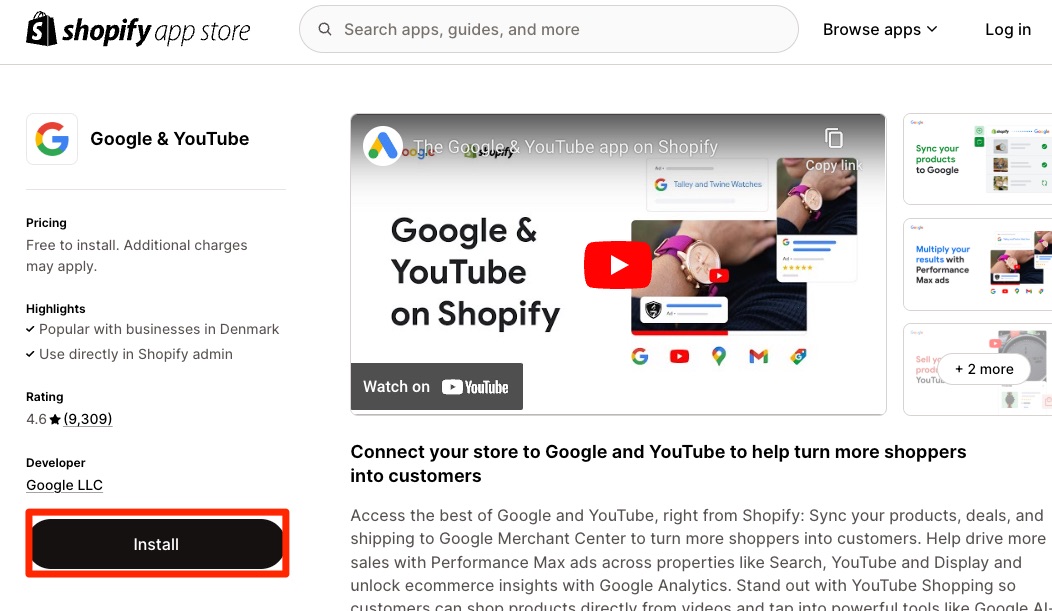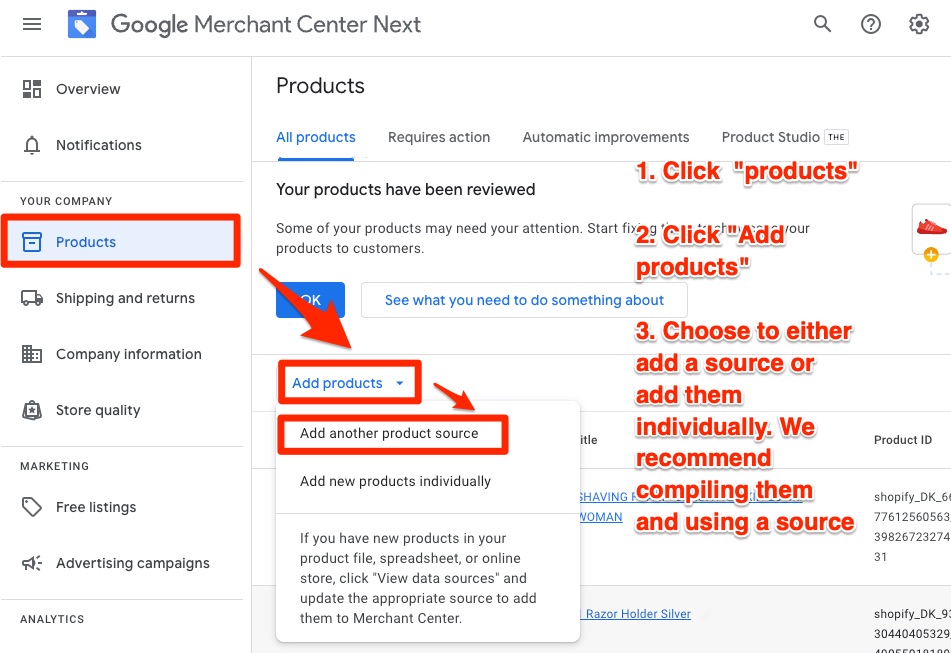Getting your products from Shopify onto Google Shopping can significantly increase your store’s visibility. When your products appear on Google Shopping, you can reach people who are already searching for items like yours. This can lead to more clicks, higher traffic, and better sales.
Below you’ll find a detailed walkthrough on the important steps to make that happen. You’ll learn how to link Shopify to Google Shopping, why you might want to use Google Ads, how to troubleshoot common problems, and how to add structured data for rich results. All of this can be done without too much complexity, and you don’t have to be an expert developer to get started.
Why Consider Google Shopping for Your Shopify Store
Many online shoppers check Google first when reading reviews, comparing prices, or looking for new brands. Google Shopping appears in search results as a grid of products, often including images, prices, and ratings. That visual layout can capture attention faster than a text-based ad.
- Google Shopping generally displays product photos, titles, and prices.
- It can send direct traffic to your product pages.
- It lets you reach shoppers who are specifically looking for what you offer.
Link Your Shopify to Google Shopping
Before your items appear on Google Shopping, you need to connect your Shopify store to a Google Merchant Center account. Merchant Center is where Google stores your product data such as titles, descriptions, prices, images, and availability. Here’s how to get everything connected:
- From your Shopify admin panel, go to “Settings,” then select “Apps and sales channels.”
- Click “Customize your store,” which takes you to Shopify’s App Store.
- Log in if necessary, and then look for the official Google Channel app.
- Select “Connect Google account” and sign in to your Google account, or create one if needed.
- Choose your Merchant Center account, or create a new one directly from within Shopify.
- Go through the verification process to prove you own the Merchant Center account.
- Choose your target market and the language for your product listings.
- Set up shipping in either “Automatic” or “Manual” mode so your items show correct shipping rates.

After these steps, your Shopify products should begin syncing automatically with Google Merchant Center. This process can take some time, and your products might not appear immediately. If your product information is correct, your items will eventually show up in Google’s free listings, meaning they can appear in Google Shopping even if you’re not paying for ads.
Should You Use Google Ads in Shopify?
Many store owners find Google Ads very useful. Google Ads let you promote your products to a larger audience. Whether you’re starting out or looking to grow, Google’s advertising platform can put your products in front of people who are searching.
There’s also the option to target specific keywords, adjust bids to control your ad spend, and check ad performance with detailed reports. If you want to drive more traffic quickly instead of waiting for natural growth, paid ads can help.
Quick Benefits of Google Ads
- You can set and control daily budgets
- Ads can appear alongside product listings
- You get data insights to refine your marketing
- There is potential for quick traffic increases
How to Get Shopify Products on Google Shopping Manually
Sometimes you may want to upload a product feed yourself. This approach can be useful if you want more control over the look of your feed or have specific needs not covered by an app. Here’s a brief guide:
- From the Shopify admin panel, click “Products.”
- Select “All products” and choose the ones you want to submit to Merchant Center.
- Export these as a file. Choose a format compatible with Google Merchant Center, like .XML or .TXT.
- In your Merchant Center account, open “Products” > “Feeds.”
- Create a new feed if you haven’t already.
- Upload the file you exported from Shopify.

Google will process your file and generate a listing for each product if all data and formatting are correct. You can also schedule automatic uploads, which is helpful if you frequently update or add new product lines in a large store.Verifying and Claiming Your Shopify WebsiteGoogle requires verification that you own any domain connected to a Merchant Center account. Verification usually involves adding a small HTML tag or file to your website. If you use Shopify, there’s a built-in method:
- Go to “Online Store” > “Preferences” in Shopify.
- Copy the code snippet from Merchant Center into the verification section.
- Click save.
- Return to Merchant Center and click “Verify.”
Once done correctly, Google will confirm your ownership. Then, you also need to claim the website to prevent others from using the same URL in another Merchant Center account.
Dealing with Product Disapprovals
Google sets strict rules about what can be listed on its platforms. Even if your items follow the guidelines, small data mistakes can lead to disapprovals. Typical reasons a product might be turned down include:
- Missing or incorrect product identifiers (like GTIN or MPN)
- Pricing on the website not matching pricing in Merchant Center
- Images that are watermarked or of low quality
- Violation of Google’s content policies
Google usually notifies you about policy violations and may give a period to fix any issues. If your feed remains noncompliant, your Merchant Center and Google Ads accounts can be suspended. It’s a good idea to double-check your data, ensure your landing pages match your feed, and test your feed before doing a full upload.Common Product Disapproval Reasons (Sample Table)
If you think there’s an error, Google allows appeals. You’ll generally find information in your Merchant Center account about which products were disapproved and why. Fix any issues and resubmit.
Selling in Multiple Countries
If you plan to advertise in different regions, you’ll need separate feeds for each country. This may involve translating your product data and adjusting currency. For example:
- In the United States, your currency is typically USD and your language is English.
- For France, your product feed should be in French, and you’ll switch the currency to EUR.
Make sure that users visiting your French site see everything in French and can pay in Euros. Google checks for alignment between your website and Merchant Center feed. If there is a mismatch, your products might be turned down. Using third-party tools or a localized version of your store can help manage these changes.
Bulk Editing Google Shopping Fields in Shopify
For larger stores with dozens or hundreds of products that need updating, the built-in bulk editing tool can save time:
- From your Shopify admin page, click “Products.”
- Use a filter to sort products by their Google status (approved, pending, or not approved).
- Select the products you want to edit.
- Click “Edit products” to open the bulk editor.
- Update fields like “Google product category,” “Structured data,” or “Age group” in bulk.
Remember to click “Save” when you’re done. You can then check Merchant Center to make sure the changes are working as expected.Structured Data and Why It MattersStructured data is a format that helps search engines better understand your site’s content. With this information, search engines can enhance your listings with details like product price, ratings, or availability directly in the search results. This makes your products more attractive to potential buyers and can feed into Google Shopping listings.
Key Points About Structured Data
- Typically provided using JSON-LD format
- Helps generate rich snippets with extra details on search results
- Can automate how your product data appears in Shopping Ads
- Must follow Google’s formatting guidelines
You can add structured data manually or use an app from Shopify’s app store. If you’re comfortable with Shopify Liquid, HTML, and JSON-LD, you might add custom markup yourself. Just be careful with coding errors that could affect your theme or prevent Google from validating your markup.How to Implement Structured DataThere are several ways to add structured data:
- Use a Shopify app that automatically applies JSON-LD markup for products, collections, blog pages, and more.
- Hire or consult a Shopify expert who can write the required code.
- Manually add JSON-LD and schema.org references to your theme if you have the necessary coding experience.
Where to Place Structured Data
Different pages need different data types, so placement can vary with your theme. Generally, you might add structured data in these theme files:
- Homepage template (often “index.liquid”)
- Product template (usually “product.liquid” or a product section in “sections/”)
- Collection template (often “collection.liquid”)
- Blog or article template (such as “blog.liquid” or “article.liquid” in “templates/”)
It is common to include multiple data types on one page. For example, your product page might include data for a breadcrumb list, product details, and offers.
Recommended Structured Data for Main Pages
Below is guidance on common data types:
Homepage
The homepage can include:
- WebSite: Describes your site as a whole.
- Organization: Shows your business name, logo, and contact details.
Blog Page
For a blog, you might add:
- Blog: General details about your blog. Alternatively, use Article or BlogPosting for individual posts.
Collection Pages
For collections, you might include:
- CollectionPage: Describes the purpose of the page, such as “Men’s Shoes.”
- ListItem: Represents the position of each product in the list.
Testing Your Structured Data
After adding structured data, it is a good idea to test it to catch any errors. Google provides a couple of tools:
- Rich Results Test: Enter a URL or paste HTML to check if the data meets Google’s requirements for rich results.
- Search Console: If you have verified your website, this tool regularly checks your pages and reports on any structured data issues.
- Schema Markup Validator: Offered by schema.org, this tool checks various types of schema for errors.
Test one product page first. Once you see no errors, check additional pages such as your homepage, product pages, collection pages, and blog posts to ensure consistency.
An Example Workflow
- Create a Google Merchant Center account and verify domain ownership.
- Link the Merchant Center to your Shopify store and let the automatic sync run.
- If something isn’t syncing properly, export your product feed manually.
- Check each feed attribute such as product title, description, link, image link, and price.
- In Merchant Center, go to “Products” > “Feeds” and upload the feed file.
- Look for any errors in the “Diagnostics” tab. Fix them and resubmit if necessary.
- Once products are approved, consider setting up a Google Ads campaign for extra visibility.
- Add structured data to your store’s pages for enhanced listings and rich results.
Frequently Asked Questions About Shopify And Google Shopping
Getting your Shopify products onto Google Shopping is a game-changer for product visibility and sales. Below are answers to common questions about setting up, optimizing, and troubleshooting your integration with Google Shopping.
Why Should I Use Google Shopping for My Shopify Store?
Google Shopping showcases your products in a visually engaging way with images, prices, and reviews, targeting shoppers already searching for items you sell. This increases exposure, drives traffic, and converts browsers into buyers effectively.
How Do I Link Shopify to Google Shopping?
You’ll need a Google Merchant Center account linked to your Shopify store through the Google Channel app. Shopify helps sync your products automatically after verifying your domain, setting up shipping methods, and selecting your target market.
Do I Need Google Ads for Google Shopping?
No, but using Google Ads can expand your visibility significantly. Ads place your products at the top of Google searches, allow keyword targeting, and provide advanced analytics, which can lead to faster and higher traffic.
What if I Want to Manually Upload My Products?
You can export product data from Shopify and upload it directly to Google Merchant Center as a .XML or .TXT file. This offers more control, though it requires accurate formatting and scheduled updates if needed.
How Do I Verify and Claim My Website for Google Merchant Center?
Copy the HTML verification code from Merchant Center into your Shopify Preferences section under "Meta Tag Verification." Save it, click “Verify” in Merchant Center, and then claim your domain.
Why Might Products Be Disapproved?
Common reasons include mismatched prices between Shopify and Merchant Center, low-quality images, missing GTINs, or policy violations (e.g., promoting restricted products). Fix errors, resubmit the feed, and consult Google’s policies for compliance.
Can I Sell in Multiple Countries?
Yes, but you’ll need separate feeds for each country. Translate your product data, update currencies, and ensure your website matches the language and currency displayed in the feed.
What Is Structured Data and Why Does It Matter?
Structured data, using JSON-LD format, helps Google display rich details like star ratings and stock availability in search results. Enhanced listings improve click-through rates and provide critical details upfront to shoppers.
How Can I Test My Structured Data?
Use Google’s Rich Results Test or Search Console to validate your structured data implementation and ensure eligibility for rich results. Test various pages, including product, collection, and homepage URLs.
What Are the Top Issues and Fixes with Google Shopping?
Pricing mismatches, missing product identifiers, out-of-stock items, or long product titles are frequent culprits. Regularly review warnings in Google Merchant Center’s Diagnostics tab, align Shopify and feed data, and promptly address errors.
Google Shopping can transform your Shopify store’s reach with the right setup and optimizations. By staying consistent and following Google's guidelines, you can create a seamless integration and attract ready-to-buy customers.
Want to try the #1 AI Toolkit for SEO teams?
Our AI SEO assistants helps write and optimize everything - from descriptions and articles to product feeds - so they appeal to both customers and search engine algorithms. Try it now with a free trial→












